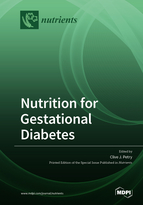Nutrition for Gestational Diabetes
A special issue of Nutrients (ISSN 2072-6643). This special issue belongs to the section "Nutritional Epidemiology".
Deadline for manuscript submissions: closed (31 December 2019) | Viewed by 97481
Special Issue Editor
Interests: diabetes; metabolism; hypertension; growth; development; imprinted genes; biomarkers; nutritional therapies
Special Issues, Collections and Topics in MDPI journals
Special Issue Information
Dear Colleagues,
Gestational diabetes mellitus (GDM) is one of the most common adverse medical conditions that occurs during pregnancy, and its prevalence is rising as part of a diabetes pandemic. Nutrition plays a key role in GDM, whether (1) as part of an ‘unhealthy’ diet, which contributes to its cause, or (2) as part of changes in dietary intake, which act as the frontline treatment for GDM (sometimes supplemented with exercise and pharmacological intervention). Dietary changes, therefore, can alter the risk of developing GDM in the first place, and once GDM has emerged during pregnancy, dietary changes can mitigate the risk of developing GDM-related complications, such as macrosomia, respiratory distress, hypoglycemia and jaundice in the neonate, pre‑eclampsia, increased need for caesarean section and placental abruption in the mother. In this Special Issue, we aim to highlight the role of nutrition in the aetiology of GDM, whether directly or indirectly through weight gain and obesity, and in its role as a GDM treatment to lower hyperglycemia and the risk of the aforementioned complications.
Dr. Clive J. Petry
Guest Editor
Manuscript Submission Information
Manuscripts should be submitted online at www.mdpi.com by registering and logging in to this website. Once you are registered, click here to go to the submission form. Manuscripts can be submitted until the deadline. All submissions that pass pre-check are peer-reviewed. Accepted papers will be published continuously in the journal (as soon as accepted) and will be listed together on the special issue website. Research articles, review articles as well as short communications are invited. For planned papers, a title and short abstract (about 100 words) can be sent to the Editorial Office for announcement on this website.
Submitted manuscripts should not have been published previously, nor be under consideration for publication elsewhere (except conference proceedings papers). All manuscripts are thoroughly refereed through a single-blind peer-review process. A guide for authors and other relevant information for submission of manuscripts is available on the Instructions for Authors page. Nutrients is an international peer-reviewed open access semimonthly journal published by MDPI.
Please visit the Instructions for Authors page before submitting a manuscript. The Article Processing Charge (APC) for publication in this open access journal is 2900 CHF (Swiss Francs). Submitted papers should be well formatted and use good English. Authors may use MDPI's English editing service prior to publication or during author revisions.
Keywords
- diabetes
- pregnancy
- carbohydrate
- glycemic index
- fat
- protein
- fiber
- vitamins
- epidemiology
- treatment







